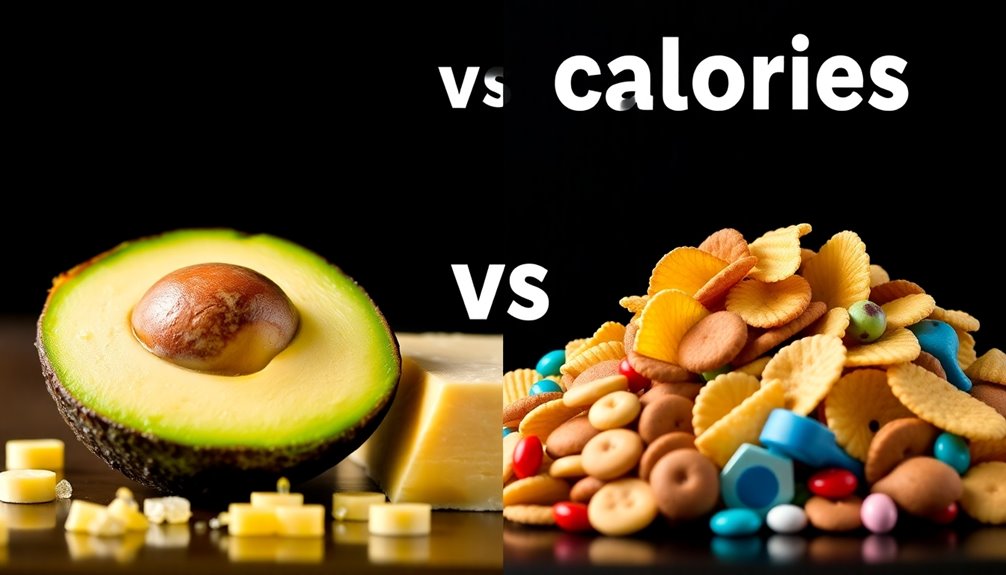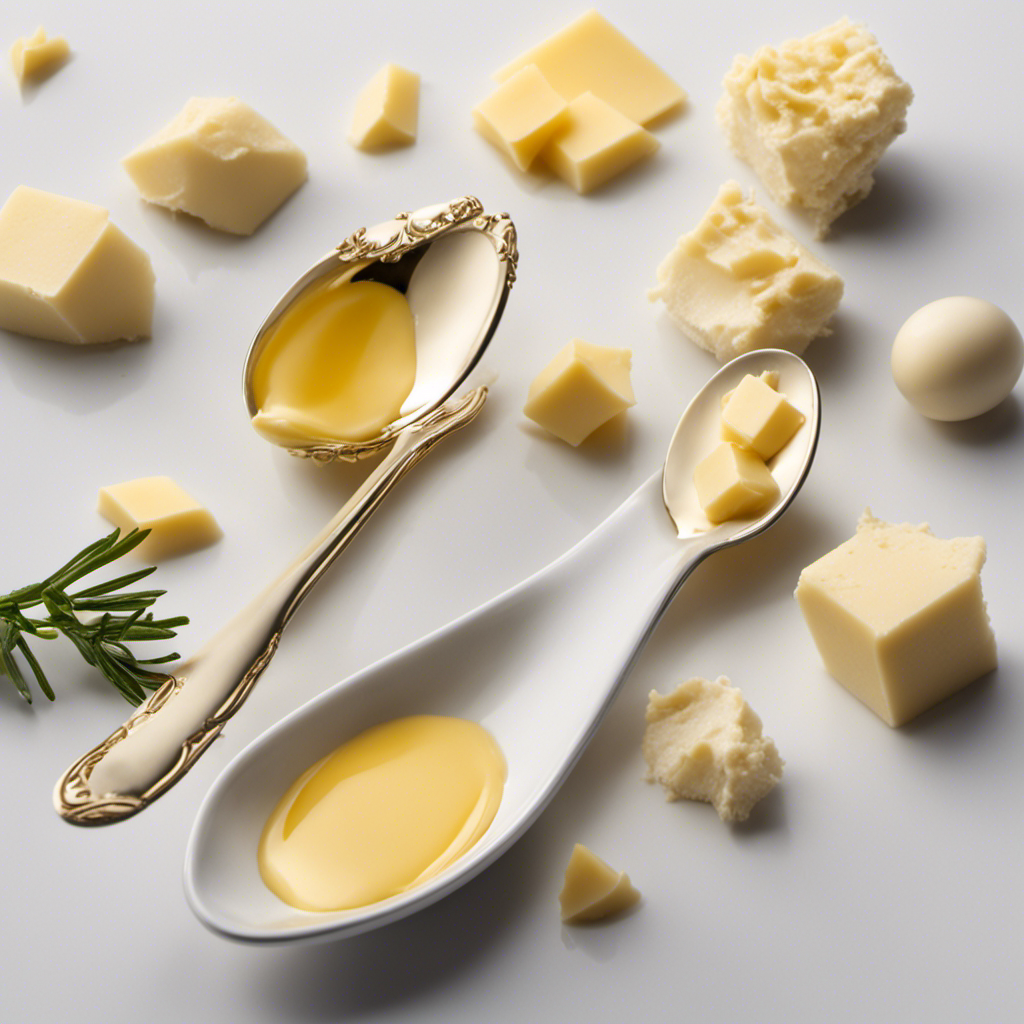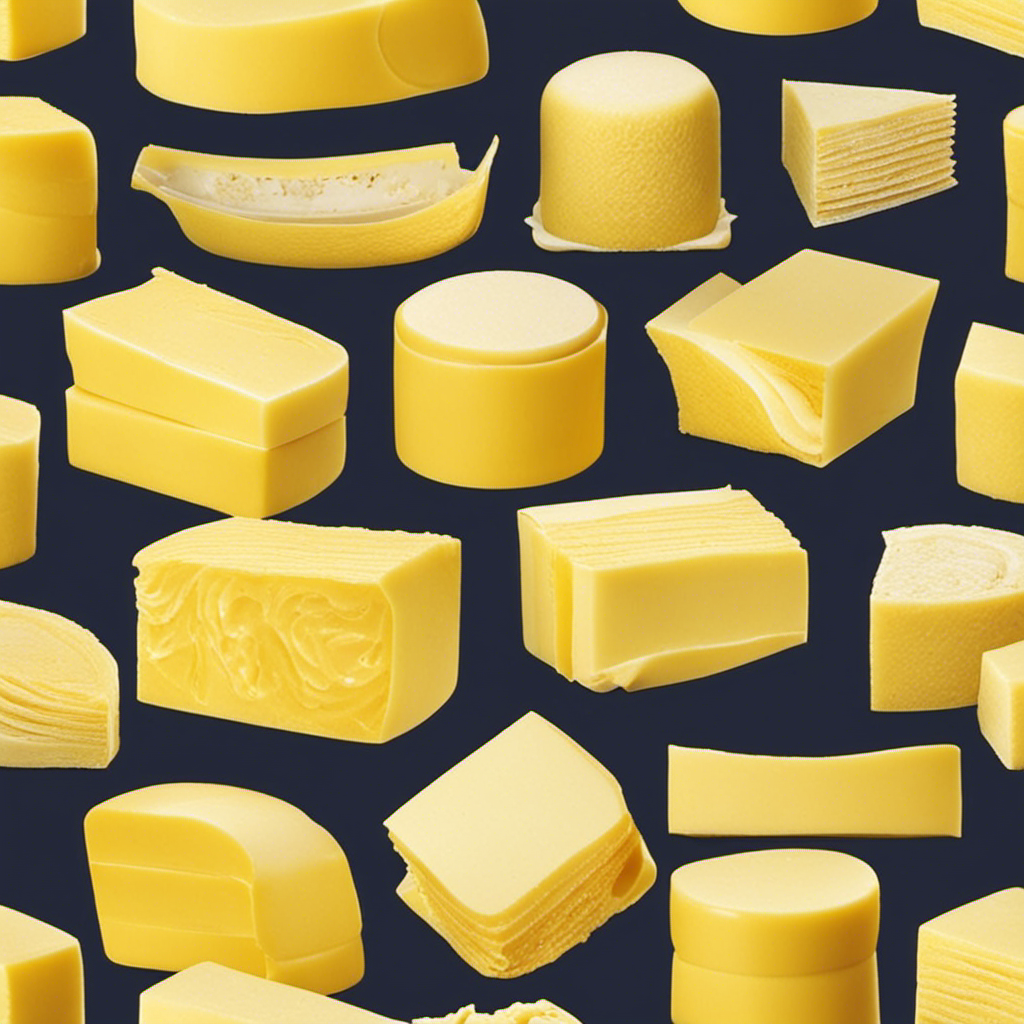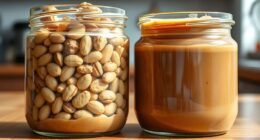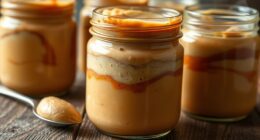I, just like many others, find myself frequently desiring a warm, flaky croissant to kick off my day. Have you ever pondered the calorie content in a croissant without butter?
In this article, I will delve into the nutritional facts and break down the calorie content of a plain croissant. We will explore the impact of butter on the calorie count and discover healthy alternatives to enjoy this delectable treat guilt-free.
So, let’s uncover the truth behind the calories in a butterless croissant.
Key Takeaways
- A plain croissant without butter has around 231 calories.
- Adding butter can increase the calorie count to around 330 calories.
- Butter alone accounts for 200 calories in a croissant.
- Using butter substitutes like margarine or vegetable oil spreads can provide a similar texture with lower saturated fat content.
Croissant Nutrition Facts
You’ll find that croissant nutrition facts can vary depending on whether or not they contain butter. While croissants are known for their delicious taste and flaky texture, they are not typically considered a healthy food choice.
However, there are some health benefits to be aware of. Croissants can provide a good source of carbohydrates, which are essential for energy. Additionally, they contain small amounts of protein and fiber.
It’s important to practice portion control when consuming croissants, as they can be high in calories and saturated fat. Opting for a smaller size or sharing with a friend can help to reduce calorie intake.
Now, let’s delve into the calorie content of a plain croissant.
Calorie Content of a Plain Croissant
The calorie content of a plain croissant can vary depending on the brand and size. When comparing the calorie count of different croissants, it’s important to consider the impact of ingredients.
The primary ingredients in a croissant are flour, butter, yeast, sugar, and salt. Butter, in particular, contributes significantly to the calorie count.
A plain croissant without butter typically has around 231 calories. However, when butter is added, the calorie count can increase to around 330 calories. This calorie comparison highlights the significant impact that butter has on the overall calorie content of a croissant.
Ingredients and Calorie Breakdown
When comparing different brands and sizes of croissants, it’s important to consider the impact of the primary ingredients on the calorie content. One of the key ingredients in a croissant is butter, which contributes significantly to its calorie count. Let’s take a closer look at the calorie breakdown of a croissant with butter.
| Ingredient | Calorie Content |
|---|---|
| Flour | 100 calories |
| Sugar | 50 calories |
| Yeast | 20 calories |
| Salt | 5 calories |
| Butter | 200 calories |
| Total Calories | 375 calories |
As you can see, butter alone accounts for 200 calories in a croissant. This high calorie content is due to the fat content in butter. If you’re watching your calorie intake, it’s important to be mindful of the impact of butter on the overall calorie count of a croissant.
Comparing Calories in Butter Vs. Butterless Croissants
When it comes to croissants, one of the key factors that can significantly impact their calorie content is the addition of butter. Understanding the calorie impact of butter in croissants is crucial for those who are watching their calorie intake or looking for a healthier option.
In this discussion, we will explore the calorie difference between butter and butterless croissants, the availability of healthier croissant options, as well as the taste comparison when butter is omitted.
Butter’s Calorie Impact
To find out how much butter affects the calorie content of a croissant, you can check the nutrition label. Many people are looking for butter alternatives to reduce their calorie intake.
Butter is high in fat and can significantly increase the calorie content of a croissant. However, it also adds richness and flavor to the pastry. If you’re trying to reduce your calorie intake, you may consider opting for a butterless croissant or choosing a lighter spread such as margarine or a low-fat cream cheese.
These alternatives can help lower the calorie content while still providing some taste and texture. It’s important to note that the specific calorie content may vary depending on the brand and recipe, so always check the nutrition label for accurate information.
Healthier Croissant Option
Opting for a lighter spread like margarine or low-fat cream cheese can provide a healthier alternative for reducing calorie intake in a croissant. By substituting butter with these options, you can enjoy a delicious croissant while still maintaining a healthier lifestyle. In fact, there are several healthy croissant recipes available that use alternative ingredients to create a butterless version. These recipes often incorporate healthier fats, such as olive oil or avocado, which provide the same richness and flavor without the added calories. Additionally, butterless croissants offer several benefits, including reduced saturated fat content and lower calorie count. Here is a table that compares the calories and fat content of a regular croissant with a butterless croissant:
| Calories | Fat (g) | |
|---|---|---|
| Regular Croissant | 231 | 12 |
| Butterless Croissant | 175 | 6 |
As you can see, opting for a butterless croissant can significantly reduce both calorie and fat intake, making it a healthier choice for those watching their weight or looking to incorporate healthier ingredients into their diet.
Taste Comparison Without Butter
If you try a butterless croissant, you’ll notice a difference in taste compared to the traditional version. The absence of butter alters the flavor profile and texture of the croissant. Without butter, the croissant may be less rich and slightly drier.
The butter in a traditional croissant contributes to its flakiness and adds a distinct, creamy taste. However, taste preferences can vary from person to person. Some individuals may prefer the lighter and less greasy texture of a butterless croissant, while others may find it lacking in flavor compared to the classic version.
Ultimately, it boils down to personal preference when it comes to deciding which croissant variant suits your taste buds best.
Impact of Butter on Croissant Calorie Count
You’ll be surprised by how much butter can significantly increase the calorie count of a croissant.
Butter not only adds flavor and richness to croissants but also affects their texture. The addition of butter creates layers of fat that result in a flaky and tender pastry.
However, it’s important to note that butter is high in calories and saturated fats, which may not be ideal for those watching their calorie intake or concerned about heart health.
Fortunately, there are butter substitutes available that can provide a similar texture without the added calories and saturated fats. These substitutes, such as margarine or vegetable oil spreads, can be used in baking to achieve a similar flaky texture while offering health benefits such as lower saturated fat content and, in some cases, added omega-3 fatty acids.
Healthy Alternatives to Butter in Croissants
When it comes to croissants, finding healthier alternatives to butter can be a game-changer. Butter substitutes not only reduce the calorie count but also offer different flavors and textures.
Additionally, exploring low-calorie croissant options can help satisfy cravings while staying mindful of one’s dietary goals.
Butter Substitutes for Croissants
There are several butter substitutes that can be used in croissants to reduce the calorie content. These substitutes not only provide a healthier alternative but also maintain the same delicious taste. Here are some popular options:
| Butter Substitute | Calorie Content per tablespoon |
|---|---|
| Coconut oil | 117 |
| Olive oil | 119 |
| Avocado | 50 |
| Greek yogurt | 18 |
| Applesauce | 25 |
Using these substitutes allows you to enjoy your favorite pastries without worrying about the health risks associated with consuming too much butter. Butter is high in saturated fats and cholesterol, which can contribute to heart disease and weight gain. By opting for these butter substitutes, you can still indulge in the flaky goodness of croissants while keeping your calorie intake in check.
Low-Calorie Croissant Options
If you’re looking for a healthier alternative, opt for low-calorie croissant options that still provide the flaky goodness you crave. Here are some options to consider:
-
Whole wheat croissants: Made with whole wheat flour, these croissants offer more fiber and nutrients compared to traditional ones.
-
Almond croissants: Almond croissants are often made with almond flour, which is lower in carbohydrates and higher in protein compared to regular croissants.
-
Vegan croissants: These croissants are made without any animal products, making them suitable for vegans. They often use plant-based butter substitutes and can still be deliciously flaky.
-
Gluten-free croissants: For those with gluten sensitivities or celiac disease, gluten-free croissants made with alternative flours like rice or tapioca flour can be a good option.
-
Reduced-fat croissants: Some bakeries offer croissants made with less butter or with lower-fat alternatives, reducing the calorie and fat content.
These low-fat croissant options and vegan croissant alternatives allow you to enjoy the indulgence of a croissant while making healthier choices.
Frequently Asked Questions
Can a Croissant Without Butter Still Be Considered a Croissant?
Yes, a croissant without butter can still be considered a croissant. It may not be as flaky, and the taste may differ from a traditional one. However, it is still a pastry made with the same dough.
Is the Calorie Content of a Plain Croissant the Same in All Bakeries?
The calorie content of a plain croissant may vary depending on the bakery. Different bakeries may use different recipes and techniques, resulting in variations in calories. It’s important to check nutritional information for accurate calorie counts.
Are There Any Other Factors Besides the Absence of Butter That Affect the Calorie Count of a Croissant?
To answer the question about factors affecting the calorie count of a croissant without butter, it is important to consider the impact of baking methods and the role of other ingredients.
What Are Some Examples of Healthy Alternatives to Butter That Can Be Used in Croissants?
Some healthy alternatives to butter that can be used in croissants include avocado, coconut oil, and Greek yogurt. These alternatives not only reduce calories, but also offer additional health benefits when used in baking.
Are There Any Other Nutritional Differences Between Butter and Butterless Croissants Besides Calorie Content?
Nutritional differences between butter and butterless croissants, beyond calories: a closer look. Let’s explore how different ingredients affect the calorie count of a croissant, going beyond the absence of butter.
Conclusion
In conclusion, after examining the calorie content of a croissant without butter, it’s clear that opting for a butterless croissant can significantly reduce the calorie intake.
By omitting butter, you can enjoy a delicious pastry without compromising on taste while also making a healthier choice.
As the saying goes, ‘less is more,’ and in the case of croissants, choosing a butterless option can be a wise decision for those watching their calorie intake.
So go ahead and indulge in a guilt-free treat!



